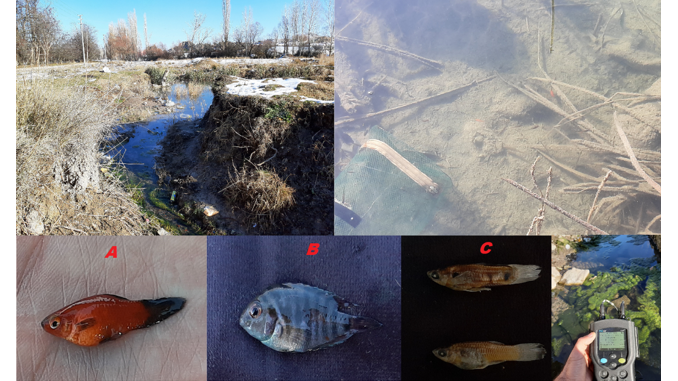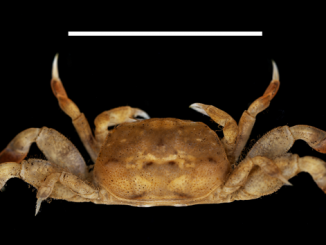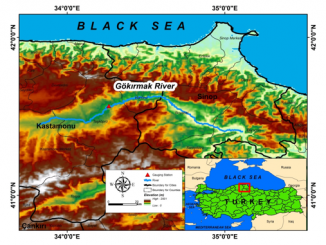
Paper category: Original research paper
Corresponding author: Sadi Aksu (sadiaksu@gmail.com)
DOI: 10.2478/oandhs-2021-0031
Received: 01/03/2021
Accepted: 26/03/2021
Full text: here
Citation (APA style): Aksu,S.,Başkurt,S.,Emiroğlu,Ö. & Tarkan,A.(2021).Establishment and range expansion of non-native fish species facilitated by hot springs: the case study from the Upper Sakarya Basin (NW, Turkey). Oceanological and Hydrobiological Studies,50(3) 247-258. https://doi.org/10.2478/oandhs-2021-0021
Abstract
Non-native species can enter new habitats and ecosystems in a variety of ways. Suitable ecological conditions must exist for non-native species to reproduce in newly colonized habitats. Hot springs are suitable habitats for tropical, aquarium, and ornamental fish species. This paper presents the results of research on the distribution of non-native and native species in relation to environmental factors in the Upper Sakarya Basin, where several such springs are present. The fish fauna in the basin includes native (60% – 21 species, 14 of which are endemic) and non-native (40% – 14 species) fish species. Most of the non-native species (seven species) were found only in warm springs (minimum water temperature 16°C). In addition, 75 fish species belonging to 26 families were found throughout the Sakarya Basin. Hot springs were found to play an important role in the establishment of non-native species. The Kernel Density Estimation (KDE) results revealed that the non-native species density was high in the Upper Sakarya Basin where hot springs are common. This confirms that minimum and maximum temperatures are the main drivers of changes in the distribution of non-native fish species. Two aquarium fishes, Bujurguina vittata and Xiphophorus spp., are reported for the first time in the present study for inland waters of Turkey.
Conclusions
Our results clearly indicate that hot water resources could be suitable habitats, especially for tropical aquarium fish species once introduced into the wild. This is also relevant to sensitive areas (i.e. biodiversity hotspots in temperate climates) in light of projected climate change due to global warming. An increase in water temperature would cause a reduction in the amount of dissolved oxygen, which is considered a limiting factor for natural species but a contributing factor for non-native species. This could consequently lead to a rapid removal of native species from the environment and a faster establishment of non-native species in these abandoned niches. Another reason for the high rate of non-native species is that hot springs provide favorable environmental conditions, especially for aquarium and ornamental fish. Hot springs are located close to highly populated areas (i.e. some metropolitan cities such as Eskişehir, Sakarya), where aquarium trade is common and this situation increases the transportation of ornamental fish to these water sources.
For the ecological status of aquatic ecosystems to be sustainable, the existing balance must be kept stable. When non-native species enter a new aquatic system, they can cause changes in the existing ichthyofauna. This situation can lead to a series of negative consequences, causing significant damage to aquatic habitats and sustainable ecological services. To prevent these negative effects and ensure sustainable ecological services of aquatic ecosystems, non-native fish species should be continuously monitored and relevant management actions should be implemented.
Competing interests
The authors declare no competing interests.
References
Aksu, S., Başkurt, S., Çiçek, A. & Emiroğlu, Ö. (2018). Seydisuyu Balık Faunasının Belirlenmesi. Research Journal of Biology Sciences 11: 42–46.
Allendorf, F.W., Leary, R.F., Spruell, P. & Wenburg, J.K. (2001). The problems with hybrids: setting conservation guidelines. Trends in ecology and evolution 16(11): 613–622.
Anderson, M., & Braak, C.T. (2003). Permutation tests for multi-factorial analysis of variance. Journal of statistical computation and simulation 73(2): 85–113.
Anderson, M., Gorley, R. & Clarke, K. (2008). PERMANOVA+ for PRIMER: guide to software and statistical methods. Plymouth: PRIMER-E Ltd; 2008.
Arslan, N., Timm, T. & Erséus, C. (2007). Aquatic Oligochaeta (Annelida) of Balıkdamı wetland (Turkey), with description of two new species of Phallodrilinae. Biologia 62(3): 323.
Bektas, Y., Turan, D., Aksu, I., Ciftci, Y., Eroglu, O. et al. (2017). Molecular phylogeny of the genus Capoeta (Teleostei: Cyprinidae) in Anatolia, Turkey. Biochemical Systematics and Ecology 70: 80–94.
Bektas, Y., Aksu, I., Kaya, C., Bayçelebi, E., Küçük, F. et al. (2020). Molecular systematics and phylogeography of the genus Alburnus Rafinesque, 1820 (Teleostei, Leuciscidae) in Turkey. Mitochondrial DNA Part A 31(7): 273–284.
Bozcaarmutlu, A., Sapmaz, C., Aygun, Z. & Arinç, E. (2009). Assessment of pollution in the West Black Sea Coast of Turkey using biomarker responses in fish. Marine Environmental Research 67(4–5): 167–176.
Bozcaarmutlu, A., Sapmaz, C., Kaleli, G., Turna, S. & Yenisoy-Karakaş, S. (2015). Combined use of PAH levels and EROD activities in the determination of PAH pollution in flathead mullet (Mugil cephalus) caught from the West Black Sea coast of Turkey. Environmental Science and Pollution Research 22(4): 2515–2525.
Chu, C., Mandrak, N.E. & Minns, C.K. (2005). Potential impacts of climate change on the distributions of several common and rare freshwater fishes in Canada. Diversity and Distributions 11(4): 299–310.
Çiçek, A., Köse, E., Emiroğlu, Ö., Tokatli, C., Aksu, S. et al. (2018). Sarısu Deresi (Eskişehir) Su Kalitesi. Biyoloji Bilimleri Araştırma Dergisi 11(2): 27–29.
Çiçek, E., Birecikligil, S.S. & Fricke, R. (2015). Freshwater fishes of Turkey: a revised and updated annotated checklist. Biharean biologist 9(2): 141–157.
Çiçek, E., Sungur, S. & Fricke, R. (2020). Freshwater lampreys and fishes of Turkey; a revised and updated annotated checklist 2020. Zootaxa 4809(2): 241–270.
Demircan, M., Gürkan, H., Eskioğlu, O., Arabaci, H. & Coşkun, M. (2017). Climate change projections for Turkey: three models and two scenarios. Türkiye Su Bilimleri ve Yönetimi Dergisi 1(1): 22–43.
Duman, A. & Helli, S. (2019). Ichthyofauna of Lake Taşkisiği (Sakarya, Turkey). International Journal of Agricultural and Natural Sciences 12(3): 52–55.
Emiroğlu, Ö. (2011). Alien fish species in upper Sakarya River and their distribution. African Journal of Biotechnology 10(73): 16674–16681.
Emiroğlu, Ö., Ekmekçi, F.G., Aksu, S., Başkurt, S., Atalay, M.A. et al. (2016). Introduction And Establishment Of Tropical Ornamental Fish, Pterygoplichthys Spp.(Actinopterygii: Siluriformes: Loricariidae) In Hot Springs: Aquarium Trade As A Potential Risk For Biodiversity In Turkey. Acta Ichthyologica et Piscatoria 46(4): 351–356
Emiroğlu, Ö., Atalay, M.A., Ekmekçi, F.G., Aksu, S., Başkurt, S. et al. (2020). One of the world’s worst invasive species, Clarias batrachus (Actinopterygii: Siluriformes: Clariidae), has arrived and established a population in Turkey. Acta Ichthyol. Piscat. 50 (4): 391–400.
Erençin, Z. (1978). Yukarı Sakarya'nın Çevre Özellikleri Üzerinde İncelemeler. Ankara Üniversitesi Veteriner Fakültesi Dergisi 25(4): 603–612.
Ficke, A.D., Myrick, C.A. & Hansen, L.J. (2007). Potential impacts of global climate change on freshwater fisheries. Reviews in Fish Biology and Fisheries 17(4): 581–613.
Freyhof, J., Baycelebi, E. & Geiger, M. (2018). Review of the genus Cobitis in the Middle East, with the description of eight new species (Teleostei: Cobitidae). Zootaxa 4535(1): 1.
Forese, R. & Pauly, D. (2019). FishBase. World Wide Web electronic publication (www.fishbase.org ver.3/2021).
Fricke, R., Eschmeyer, W.N.R. & Van Der Laan, R. (Eds). (2021). Eschmeyer's Catalog of Fıshes: Genera, Species, References, http://researcharchive.calacademy.org/research/ichthyology/catalog/fishcatmain.asp.Electronic version accessed 3/2021.
Fuller, P.L. (2003). Freshwater aquatic vertebrate introductions in the United States: patterns and pathways. Invasive species: vectors and management strategies. Island Press, Washington DC 123–151.
Gallardo, B., Zieritz, A. & Aldridge, D.C. (2015). The importance of the human footprint in shaping the global distribution of terrestrial, freshwater and marine invaders. PloS one 10(5): e0125801
Geldiay, R. & Balik, S. (2007). Türkiye Tatlısu Balıkları, Ege Üniversitesi Basımevi. Bornova, Izmir.
Giannetto, D., Carosi, A., Ghetti, L., Pedicillo, G., Pompei, L. et al. (2013). Ecological traits of Squalius lucumonis (Actinopterygii, Cyprinidae) and main differences with those of Squalius squalus in the Tiber River Basin (Italy). Knowledge and Management of Aquatic Ecosystems (409): 04.
Gozlan R.E. (2008). Introduction of non‐native freshwater fish: is it all bad?. Fish and Fisheries 9(1): 106–115.
Gozlan, R.E., St-Hilaire, S., Feist, S.W., Martin, P. & Kent, M.L. (2005). Disease threat to European fish. Nature 435(7045): 1046–1046.
Harrison, T.D., & Whitfield, A.K. (2006). Temperature and salinity as primary determinants influencing the biogeography of fishes in South African estuaries. Estuarine, Coastal and Shelf Science 66(1–2): 335–345.
Hart, T.C. & Zandbergen, P.A. (2014). Kernel density estimation and hotspot mapping: Examining the influence of interpolation method, grid cell size, and bandwidth on crime forecasting. Policing An International Journal of Police Strategies and Management 37(2): 305–323. DOI: 10.1108/PIJPSM-04-2013-0039.
Hsieh, H.J., Hsien, Y.L., Jeng, M.S., Tsai, W.S., Su, W.C. et al. (2008). Tropical fishes killed by the cold. Coral reefs 27(3): 599.
İnnal, D. & Sungur, S. (2019) First Record Of Non-Indigenous Fish Hemichromis letourneuxi (Cichlidae) From Pınarbaşı Creek (Burdur, Turkey). Mehmet Akif Ersoy Üniversitesi Fen Bilimleri Enstitüsü Dergisi 10(1): 90–94.
Jeschke, J.M. & Strayer, D. L. (2006). Determinants of vertebrate invasion success in Europe and North America. Global Change Biology 12(9): 1608–1619.
Keskin, E. (2014). Detection of invasive freshwater fish species using environmental DNA survey. Biochemical Systematics and Ecology 56: 68–74.
Kline, R.B. (2013). Beyond Significance Testing: Statistics Reform in the Behavioral Sciences. 2nd ed., American Psychological Association, Washington DC, USA.
Kottelat, M. & Freyhof, J. (2007). Handbook of European freshwater fishes. Publications Kottelat.
Köse, E., Tokatli, C., & Çiçek, A. (2014). Monitoring Stream Water Quality: A Statistical Evaluation. Polish Journal of Environmental Studies 23(5).
Köse, E., Çiçek, A., Uysal, K., Tokatli, C., Arslan, N. et al. (2016). Evaluation of surface water quality in Porsuk Stream. Anadolu Üniversitesi Bilim ve Teknoloji Dergisi-C Yaşam Bilimleri Ve Biyoteknoloji 4(2): 81–93.
Kurtul, I. & Sari, H.M. (2019). The Features, Current Status and Ecological Risks of Invasive Gambusia Species (Gambusia holbrooki ve G. affinis) in Turkey. Journal of Limnology and Freshwater Fisheries Research 3(1): 51–60.
Lehtonen, H. (1996). Potential effects of global warming on northern European freshwater fish and fisheries. Fisheries Management and Ecology 3(1): 59–71.
Lodge, D.M., Taylor, C.A., Holdich, D.M. & Skurdal, J. (2000). Nonindigenous crayfishes threaten North American freshwater biodiversity: lessons from Europe. Fisheries 25(8): 7–20.
Magnuson, J.J., Webster, K.E., Assel, R.A., Bowser, C.J., Dillon, P.J. et al. (1997). Potential effects of climate changes on aquatic systems: Laurentian Great Lakes and Precambrian Shield Region. Hydrological processes 11(8): 825–871.
Mamun, M., Kim, S. & An, K.G. (2018). Distribution pattern prediction of an invasive alien species largemouth bass using a maximum entropy model (MaxEnt) in the Korean peninsula. Journal of Asia-Pacific Biodiversity 11(4): 516–524.
Marceniuk, A.P., Rotundo, M.M., Caires, R.A., Cordeiro, A.P.B., Wosiacki, W.B. et al. (2019). The bony fishes (Teleostei) caught by industrial trawlers off the Brazilian North coast, with insights into its conservation. Neotropical Ichthyology 17(2): e180038
Mccauley, R. & Beitinger, T. (1992). Predicted effects of climate warming on the commercial culture of the channel catfish, Ictalurus punctatus. Geojournal 28(1): 61–66.
McArdle, B.H. & Anderson, M.J. (2001). Fitting multivariate models to community data: A comment on distance-based redundancy analysis. Ecology 82(1): 290–297.
Memis, D. (2014). A short history of sturgeon caviar production in Turkey. Journal of Applied Ichthyology, 30(6): 1552–1556.
Memiş, D., Tosun, D.D., Yamaner, G., Tunçelli ,G. & Gessner, J. (2019). Present Status of Sturgeon in the Lower Sakarya River in Turkey. Aquatic Research 2(2): 53–60.
Miller, R.R., Williams, J.D. & Williams, J.E. (1989). Extinctions of North American fishes during the past century. Fisheries 14(6): 22–38.
Moore, R. D., Nelitz, M., & Parkinson, E. (2013). Empirical modelling of maximum weekly average stream temperature in British Columbia, Canada, to support assessment of fish habitat suitability. Canadian Water Resources Journal, 38(2), 135–147.
Rahel, F.J. & Olden, J.D. (2008). Assessing the effects of climate change on aquatic invasive species. Conservation biology 22(3): 521–533.
Özşahin, E. & Kaymaz, Ç.K. (2013). Türkiye’nin Termal Su Kaynaklarinin Coğrafi Açidan Değerlendirilmesi. Atatürk Üniversitesi Sosyal Bilimler Dergisi 50: 25–28.
Özuluğ, M., Tarkan, A.S., Gaygusuz, Ö. & Gürsoy, Ç. (2007). Two new records for the fish fauna of Lake Sapanca Basin (Sakarya, Turkey). Journal of Fisheries Sciences 1(3): 152–159.
Pompei, L., Giannetto, D. & Lorenzoni, M. (2018). Range expansion of an invasive goby in the River Tiber basin (Central Italy): effects on the abundance and shelter occupancy of a congeneric native goby. Aquatic Invasions 13(2).
Reis, İ., Cerim, H. & Ateş, C. (2018). First Confirmed Record for the Lepomis gibbosus (L., 1758) in The Lower Sakarya River Basin (Turkey). Journal of Limnology and Freshwater Fisheries Research 4(3): 189–191.
Rodriguez, C.M. (1997). Phylogenetic analysis of the tribe Poeciliini (Cyprinodontiformes: Poeciliidae). Copeia 4: 663–679.
Rosen, D.E. & Bailey, R.M. (1963). The poeciliid fishes (Cyprinodontiformes): their structure, zoogeography, and systematics. Bulletin of the AMNH; v. 126, article 1.
Schmitter-Soto, J.J. (2007). A systematic revision of the genus Archocentrus (Perciformes: Cichlidae), with the description of two new genera and six new species. Zootaxa (1603): 1–154.
Sharma, S., Jackson, D.A., Minns, C.K. & Shuter, B.J. (2007). Will northern fish populations be in hot water because of climate change?. Global Change Biology 13(10): 2052–2064.
Silverman, B.W. (1986). Density estimation for statistics and data analysis (Vol. 26). CRC press.
Tarkan, A.S. (2006). A Story of Pirana in Sapanca Lake. Av Doğa, 41: 75–77
Tarkan, A.S., Marr, S.M. & Ekmekçi, F.G. (2015). Non-native and translocated freshwater fish. FiSHMED Fishes in Mediterranean Environments 3: 1–28.
Turan, D., Ekmekçi, F.G., Luskova, V. & Mendel, J. (2012). Description of a new species of genus Gobio from Turkey (Teleostei: Cyprinidae). Zootaxa 3257(1): 56–65.
Turan, D., Kaya, C., Geiger, M. & Freyhof, J. (2018). Barbus anatolicus, a new barbel from the Kızılırmak and Yeşilırmak River drainages in northern Anatolia (Teleostei: Cyprinidae). Zootaxa 4461(4): 539–557.
TUIK (2020). İllere göre il/ilçe merkezi, belde/köy nüfusu ve yıllık nüfus artış hızı, 2018, 2019. https://data.tuik.gov.tr/Bulten/Index?p=Adrese-Dayali-Nufus-Kayit-Sistemi-Sonuclari-2019-33705. Access date:15.12.2020
Türkmen, G. (2019). Lepistes (Poecilia reticulata Peters, 1859)’in Türkiye içsularından ilk kaydı. Su Ürünleri Dergisi 36(4): 1–1.
Yamada, M., Shoji, J., Ohsawa, S., Mishima, T., Hata, M. et al. (2017). Hot spring drainage impact on fish communities around temperate estuaries in southwestern Japan. Journal of Hydrology: Regional Studies 11: 69–83.
Yoğurtçuoğlu, B. & Ekmekçi, F.G. (2018). First Record Of The Giant Pangasius, Pangasius sanitwongsei (Actinopterygii: Siluriformes: Pangasiidae), From Central Anatolia, Turkey. Acta Ichthyologica et Piscatoria 48(3): 241–244



